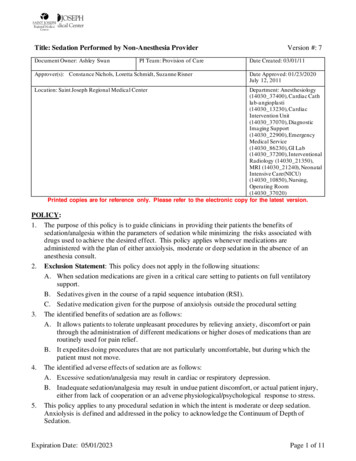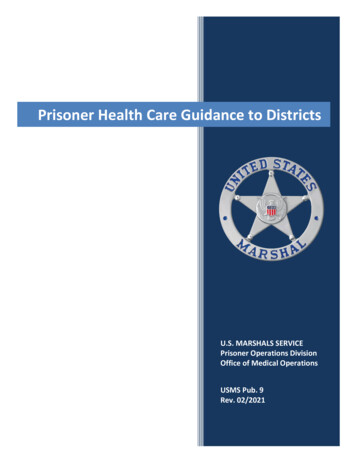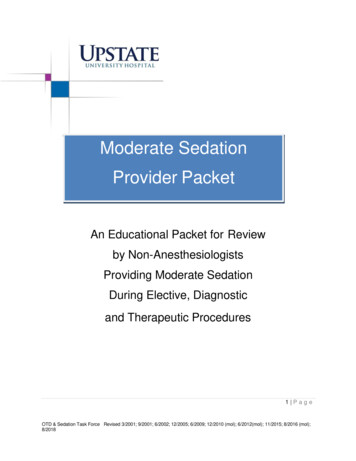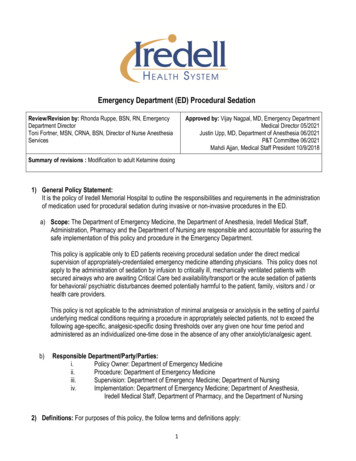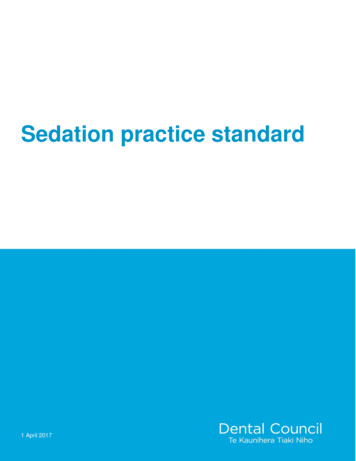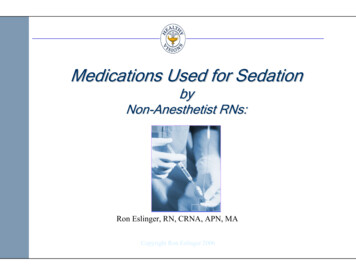
Transcription
Medications Used for SedationbyNon-Anesthetist RNs:Ron Eslinger, RN, CRNA, APN, MACopyright Ron Eslinger 2006
Agents Used For Moderate SedationBenzodiazepines– Most widely used drug for Sedation– Probably work in limbic system and amygdala ofthe brain, where fear, anxiety and apprehensionarise.– When Benzodiazepines come to these receptorsfrom the blood stream, they go into the receptorsites and cause specific effects:Copyright Ron Eslinger 2006
BenzodiazepinesEffectsQQQQQQanxiolysis . reduction of anxietyamnesiac . makes patient have antero-grade amnesia (notretrograde)anti-convulsive . stops seizuresskeletal muscle relaxationsedative - hypnotic in large dosespatients who chronically take Cimetidine (Tagamet) orRanitidine (Zantac) are especially susceptible to Benzodiazepineoverdose these H-2 blocking drugs may dramatically increasethe sedative of even small doses of Benzodiazepine.Copyright Ron Eslinger 2006
BENZODIAZEDPINESSedative hypnoticNo analgesic propertiesUseful for seizuresCopyright Ron Eslinger 2006
BENZODIAZEPINES(2)Little respiratory or cardiovascular depressionwhen used alone, but synergistic effects seenwhen combined with other CNS depressantsAvoid use in pregnancy, alcohol intoxication,glaucoma, other CNS depressantsCopyright Ron Eslinger 2006
MIDAZOLAM (VERSED)Most commonly used sedative used for conscioussedation3-5 times more potent than diazepamRarely precipitates or causes pain on injection (asvalium will)Copyright Ron Eslinger 2006
Midazolam (2)Titrate to effect in 0.5 mg incrementsRouteIVIMOralOnset of ActionPeak Effect1 minute5-15 minutes 10 minutes3-5 minutes15-60 minutes30 minutesCopyright Ron Eslinger 2006Duration ofAction15min. – 6hours2-6 hours2-6 hours
Diazepam (Valium)Used less than MidazolamTitrate in 2.5mg incrementsIncompatible with other agents,easily precipitatesCopyright Ron Eslinger 2006
Diazepam (2)Painful on injectionPeak effect in less than 10 minutesLong half-life due to metabolitesRouteIVOralOnset of ActionPeak Effect1-5 minutes15-60 minutes3-5 minutes60 minutesCopyright Ron Eslinger 2006Duration ofAction15-60 minutes3-6 hours
Reversal for BenzodiazepinesFlumazenil (Romazicon) (Specific Benzodiazepineantagonist)Initial Dose: 0.2 mgAdministration Technique:– Phase One: Initially 0.2 mg IV over 15 seconds. Ifpatient does not reach desired level of consciousness after45 seconds.– Phase Two: Repeat dose at one minute intervals until acumulative dose of 1mg has been administered (thisincludes initial dose in phase one).Copyright Ron Eslinger 2006
Reversal for BenzodiazepinesPeak effect:– 6 to 10 minutes– 80% of the maximum response is seen within 3minutes.– Anesthesia should be involved if there is nodesired clinical response with theadministration of the initial 1 mg dose.Copyright Ron Eslinger 2006
Reversal for BenzodiazepinesPotential Adverse Reactions:– nausea, vomiting, sweating, hot flashes, agitation,headache, injection site pain– do not use Flumazenil in patients who chronically takeBenzodiazepines.May precipitate:– tremors– profuse sweating– hypotension– seizure activityCopyright Ron Eslinger 2006
Flumazenil (Romazicon)Indications: reversal of benzodiazepines’effects - sedation, respiratory depression,amnesiaDose: 0.2 mg IV initially, titrate to effectCaution in patients with seizure disorders - mayreverse effects of anti-seizure medicationsCopyright Ron Eslinger 2006
Reversal Flumazenil (Romazicon)RouteIV bolusor infusionOnset ofAction1-2 minutesPeak EffectDuration ofAction6-10 minutes (but 80% of the45-90maximum response is seen within 3 minutesminutes.)Call anesthesia if there is nodesired clinical response with theadministration of the initial1 mg.Copyright Ron Eslinger 2006
NarcoticsNarcotics– (commonly given along with Benzodiazepines)– are great potentiators of respiratory depression whenmixed. (great synergistic effect)Most Common– Morphine– Fentanyl– DemerolCopyright Ron Eslinger 2006
OpioidsNo amnestic effectsProvide analgesia and sedationAdverse reactions:- Respiratory depression- Nausea and vomiting- Pruritis, urticaria- Urinary retention (young males)- ConstipationCopyright Ron Eslinger 2006
MorphineDose is up to 0.15 mg/kgPeak effect in 5-20 minutes, onset time less thanone minute, duration 2-7 hours.Possible histamine release, all of opioid sideeffects most possible with morphine.Copyright Ron Eslinger 2006
MorphineRouteOnset ofActionPeak EffectDuration ofActionIV 1 minute5 - 20 minutes4-7 hoursIM5 – 10 minutes 30-60 minutes4-7 hoursOralWithin 1 hour6-12 hours1-2 hoursCopyright Ron Eslinger 2006
Meperidine (Demerol)One tenth the potency of morphineIV dose is 0.5-1.0 mg/kgOnset in less than one minute, peak effect in 5-20minutes, duration 2-4 hours.Caution in patients with renal/hepatic impairment,Monoamine oxidase inhibitors (MAOIs) (used fordepression, isoniazid (TB Treatment)Copyright Ron Eslinger 2006
Meperidine (Demerol)RouteOnset of ActionPeak EffectDuration ofActionIV1 minutes5-20 minutes2-4 hoursIM1 – 5 minutes30-50 minutes2-4 hoursOral15-45 minutes60 minutes2-4 hoursCopyright Ron Eslinger 2006
Fentanyl (Sublimaze)75-100 times more potent than morphineDose 0.7-1mcg/kgOnset within 30 seconds, peak effect in 5-15minutes, duration of effects 30-60 minutesTitrate in 25 mcg incrementsCopyright Ron Eslinger 2006
Fentanyl (Sublimaze)RouteIVIMOnset ofActionPeak EffectDuration ofAction 1 minute5-15 minutes30-60 minutes5-8 minutes 15-20 minutesTransmuco 5-15 minutessal20 – 30minutesCopyright Ron Eslinger 20061-2 hours1-2 hours
Naloxone (Narcan)Dose: 0.5-1.0 mcg/kgAll opioid effects, inclusive of analgesia, arereversedTitrate to effectAvoid rapid reversal - can lead to untowardsympathetic discharge, extreme pain, anxiety,pulmonary edemaCopyright Ron Eslinger 2006
Reversal Naloxone (Narcan)RouteIVOnset ofActionPeak EffectDuration ofAction1-2 minutes5-15 minutes1-4 hoursCopyright Ron Eslinger 2006
Ketamine (Ketalar)Dissociative anesthetic/analgesic agentDerivative of phencyclidine(PCP)Excellent analgesic and amnesticCopyright Ron Eslinger 2006
Ketamine (2)Indications: Short term procedures requiringintense analgesiaGiven IV by the operator, monitored by themonitorContraindications: manyCopyright Ron Eslinger 2006
Ketamine (3)Contraindications: Increased ICP (increases ICP) Corneal lacerations (increases intraocularpressure) Children with active URI (stimulates oralsecretions), psychiatric disorders (may causeextreme mood alteration), compromisedairways (may induce apnea/anesthesia)Copyright Ron Eslinger 2006
Ketamine(4)Recommended dosages: 0.25-0.5 mg/kg IV, 1-2mg/kg IMOnset of action IV 30 sec, IM 5-20 min; peak effectIV 1 min, IM 3-4 min; duration of action IV 5-15min, IM 12-25 minRouteOnset ofActionPeak EffectDurationIVImmediate15 to 30seconds5 to 10minutesCopyright Ron Eslinger 2006
PropofolDIPRIVAN (Propofol) is an intravenous sedative-hypnoticagent commercially introduced in the United States in1989 by Zeneca Pharmaceuticals. It was the first of a newclass of intravenous anesthetic agents - the alkylphenols.RouteOnset ofActionPeak EffectDuration ofActionIV40 seconds1 minute5-10 minutesCopyright Ron Eslinger 2006
PropofolDosage/Administration – Adult dose: 25 – 50mg (0.5 – 1mg/kg) IV, administered in 10 mg increments over severalminutes. Pain on injection is decreased with IV lidocaine, 0.1mg/kg, added to the diprivan emulsion. Strict aseptic techniquemust be maintained in handling, as diprivan is preservative freeand will support bacterial growth. Diprivan injection should beprepared for single patient use only, just prior to the initiation ofeach procedure. Discard after opened for 6 hours.Pediatric dose: 0.5 – 1.0mg/kg infused slowly and titrated todesiredeffect.Copyright Ron Eslinger 2006
Adverse ReactionsRespiratory effects – respiratory depression, apnea,hiccup, bronchospasm, laryngospasmCardiovascular effects –hypotension, arrhythmia,tachycardia, bradycardia, hypertensionCNS effects – headache, dizziness, euphoria,myoclonic/clonic movement, seizures, sexual illusions.Copyright Ron Eslinger 2006
Emergency MedicationsAtropine: Increases heart rate by blocking vagal nervestimulation. IV bolus 0.4-1.0 mg.Lidocaine: Drug of choice for ventricular dysrhythmias decreases automaticity. IV bolus 50-100 mg.Ephedrine: Increases blood pressure and heart rate byindirect cardiac stimulation. IV bolus 5-10 mg.Copyright Ron Eslinger 2006
Questionswww.sedationcertification.comCopyright Ron Eslinger 2006
Title: Microsoft PowerPoint - Sedation SGNA 6 hours Author: Ron Created Date: 5/19/2008 1:00:55 PM
